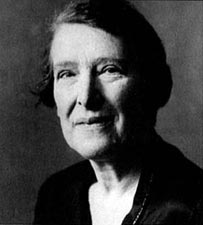
Henrietta Mabel May, photo Melvin Ormond Hammond, 1931
BIOGRAPHY
The lively and energetic «Henry» was born to Evelyn Henrietta Walker and Edward May, a self-made man who became the mayor of Verdun and a successful real-estate développer. Once he prospered, he moved his family up the hill to the more prestigious Westmount.
May was among the first to renroll in the Arts Association of Montreal in 1902. In her mid-twenties at the time, she had delayed her education to help with her nine younger brothers and sisters. In 1912, after completing her studies with William Brymner at the Art Association (1909-1912), she and Emily Coonan travelled to France, England, and Holland, where they visited galleries, studied and painted. She was particularly influenced by the Impressionists.
Upon returning to Montreal, she lived with her family at 434 Elm Avenue, set up a studio at 745 St. Catherine Street West, and spent her summers painting at the family cottage in Hudson. Anne Savage recalled : «She spent some time in France, came back radiant – she loved live».
The Depression brought with it financial problems. The family sold the cottage, and May began teaching to support herself. She continued to exhibit regularly, organized sketching classes in the Eastern Townships. Eventually she found a permanent position teaching art history at Elwood, a private girls’ school in Ottawa. From 1938 to 1947 she ran the very successful Saturday morning «Happy Art Class» at the National Gallery.
In 1948 she returned to Montreal, where she continued to teach privatly until 1950 when she moved to Vancouver to be near her sisters. At the time the Toronto Star referred to her as the Emily Carr of Montreal. She rented a studio, taught one or two pupils, and lived a quiet and secluded life. May died Vancouver at the age of ninety-four on October 8, 1971.
SUBJECTS
Anne Savage recalled : «She painted in the landscapes of the Eastern Townships where she built up her singing happy pictures». Commissioned by the Canadian Memorials Fund to record the home front during the First World War, May painted a large unusual scene of women working alongside men in a munitions factory. In 1918 she painted a number of works of women working in a munition factories for the Canadian War Memorials. She was paid the then remarkable wage of $250 a month. She painted with her friends in the Eastern Townshis, New England, and Baie St-Paul in the Lower St. Lawrence area.
TECHNIQUE
Anne Savage recalled : «She was a brillant figure at the gallery. She painted with such vigour and strength – gay, rhythmic colour using the impressionist’s technique of scintillating colour». Early paintings show the influence Impressionism, whereas landscapes after 1920 are marked by the style of the Group of Seven. During the 1920s Albert Laberge, the art critic for La Presse, placed her in the highest ranks of Montreal painters and praised her powerful originality, strong talent for colour, and Craftsmanship. Her mature works become increasingly more linear, rhythmical, and simplified in colour. The Ottawa Citizen’s review of solo exhibition at James Wilson & co in 1939 noted : «Miss May is interested in form and rhythm perspective rather than in the more external manifestations of nature. There is a sweep to most of her landscapes and a skilful arrangement of mass and colour. Some are somber and others are Bright, but all have a notable unity in conception and manage to suggest the essental nature of the scenes depicted».
MEMBERSHIPS
In 1915 she was elected an associate of the Royal Canadian Academy, and in 1920, together with Randolph Hweton, Edwin Holagate, and Lilias Torrance Newton, sher fonded the Beaver Hall Group. She participated in the founding of the Atelier in 1931ans in 1933 she was a founding member of the Canadian Group of Painters.
AWARDS
In 1929 May received honourable mention in the National Gallery’s prestigious Willingdon Arts Competition.
EXHIBITIONS
The National Gallery bought four of her works between 1913 and 1924 and several more later. From 1938 to 1947 she showed her work with a group called Le Caveau. She had a retrospective show and sale of one hundred of her paintings in 1952 at the Vancouver Art Gallery
Source: Evelyn Walters, The women of the Beaver Hall. Canadian modernist painters, Toronto, Dundurn Press, p. 61-72 ; Canadian Women Artists History Initiative